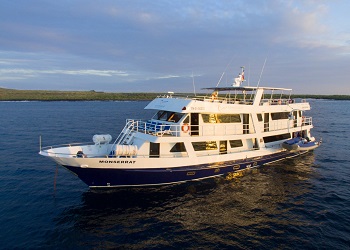Ocean Spray - Itinerary B - 5 days
ITINERARY B - 5 DAYS
TUESDAY
AM: Baltra: Arrival and Transfer to the boat
PM: Bartolome (HK/SN/PR)
WEDNESDAY
AM: Genovesa: Darwin Bay (HK/SN/PR/PB/KY)
PM: Genovesa: El barranco (HK/SN/PR/PB/KY)
THURSDAY
AM: Santiago: Espumilla beach / Buccaneer Cove (HK/SN/PR/PB/KY)
PM: Santiago: Egas Port (HK/SN)
FRIDAY
AM: North Seymour (HK/SN/PR)
PM: Santa Cruz: Highlands (HK)
SATURDAY
AM: Mosquera Islet (HK/SN)
Baltra: Transfer to the Airport
DAY 1: TUESDAY
AM: BALTRA ARRIVAL AND TRANSFER TO THE BOAT
Welcome to the incredible Galapagos Islands and your luxury catamaran, the M/C Ocean Spray! Upon arrival onboard the vessel, your guide and crew members will greet you and take you to your accommodations. After freshening up, a short briefing will be given on health, safety and emergency protocols, and you will be given a description of normal routines and different areas aboard the M/C Ocean Spray.
PM: BARTHOLOME: PINNACLE ROCK
Pinnacle Rock is a volcanic cone formed by magma expelled by an underwater volcano. The sea cooled the hot lava and as it exploded from contact, the pieces formed together this huge rock of many, many layers of basalt. The huge rock also has a beach where a small population of green sea turtles will nest during breeding season. Galapagos penguins gather here and swimming can offer beautiful sights of colorful schools of fish and curious sea lions.
DAY 2: WEDNESDAY
AM: GENOVESA: DARWIN BAY
PDarwin Bay used to be a shield volcano, now you can see where one of the sides of its caldera collapsed after hundreds of years of erosion. It is known for the wide variety of birds that can be seen. Over 20,000 red-footed boobies are estimated to call this island home within the trees and bushes of Genovesa Island.
PM: GENOVESA: EL BARRANCO / PRINCE PHILLIP`S STEPS
In English, this visitor site is also known as Prince Phillip’s Steps. It leads to a rocky path up a cliff that rewards guests with a remarkable view. It is also home to a Palo Santo forest that is home to the nesting red-footed boobies and other shorebirds.
DAY 3: THURSDAY
AM: SANTIAGO: ESPUMILLA BEACH / BUCCANEER COVE
As the second Island Charles Darwin discovered, it was originally named after King James of England. Buccaneer Cove is an excellent opportunity for snorkeling and was once a refuge for passing sailors and pirates. The underwater formations provide an amazing home for the many different tropical species of fish that can be found here.
PM: SANTIAGO: EGAS PORT
Egas port is also known as James Bay, home to quick-footed Galapagos lava lizards. There are grottos and tide pools housing all kinds of different marine species. This is also one of the best snorkeling sites in the Galapagos.
DAY 4: FRIDAY
AM: NORTH SEYMOUR
The island was named after English nobleman Lord Hugh Seymour. Formed by uplifted submarine lava, the island is home to a huge colony of about 2,500 land iguanas and large populations of sea lions, blue-footed boobies, common noddies, and frigatebirds. Along the coast, it is possible to see land and marine iguanas and the biggest colony of Magnificent Frigatebirds.
PM: SANTA CRUZ : HIGHLANDS
The Highlands of Santa Cruz is a very interesting site due to the rich wildlife, hills, ferns, volcanoes and lava tubes present. Exploring the lava tubes is a surreal and unique experience. Here you can see all the different agricultural zones that are present in the Galapagos in one place. The variety of birds makes this a bird watchers delight.
DAY 5: SATURDAY
AM: MOSQUERA ISLET
This visitor site is located between the islands of Baltra and North Seymour. It is a reef of rocks and coral (the result of an uprising) and a great white sand beach. Its narrowest width reaches about 160 meters and has an estimated length of 600 meters. In most of the perimeter there is a base of lava rocks, as evidence of the lava uprising, except in the southwest side where the landing occurs. This island has one of the largest populations of sea lions. You can also observe several species of shorebirds. There have been occasional reports at this site of Orcas (Orcinus orca) feeding on sea lions.
After this last visit, transfer to Baltra airport for your return flight to mainland Ecuador.
TRANSFER TO BALTRA AIRPORT
Assistance and farewell at the airport.
On the last day of your cruise, the only visit you have is to Mosquera Islet. Afterwards, you´ll board the M/C Ocean Spray to gather your belongings and freshen up for your transfer to the airport.







